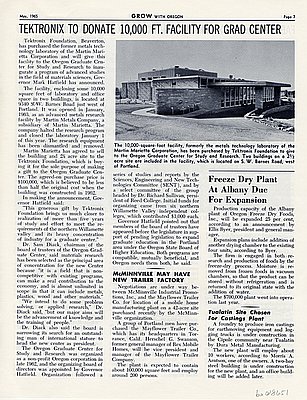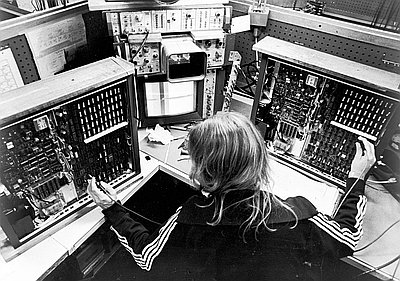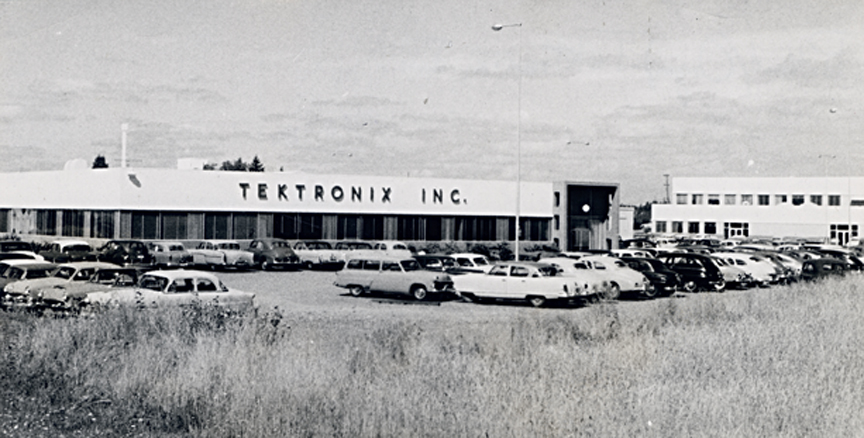- Catalog No. —
- ba018652
- Date —
- October 3, 1954
- Era —
- 1950-1980 (New Economy, Civil Rights, and Environmentalism)
- Themes —
- Science, Medicine, and Technology, Trade, Business, Industry, and the Economy
- Credits —
- Self-indexing photo file #94-A, Oregon Historical Society Research Library
- Regions —
- Portland Metropolitan
- Author —
- Oregon Journal
Tektronix's Sunset Plant
This photograph depicts Tektronix's plant at Sunset Highway and Barnes Road. The oscilloscope manufacturer moved to this new, state-of-the-art facility in 1951, having outgrown its plant on Hawthorne Boulevard in Southeast Portland. The photograph accompanied an October 3, 1954, Oregon Journal article describing the history of industry in Tualatin Valley, a region southwest of Portland that comprises much of Washington County. The article noted a shift from the area's agricultural past as post-war housing developments and new industries, such as Tektronix, moved in.
The Oregon Journal attributed Tualatin Valley's diversification in industry to a post-war housing boom led by developers catering to "Portland suburbanites." The population growth of the county spawned industries to serve and employ its new residents. Also contributing to the valley's new business and domestic populations was the increasingly limited availability of industrial sites in Portland.
The relocation of Tektronix, a young but growing company in 1954, was a case in point. Howard Vollum, Jack Murdock, Glenn Mcdowell, and Miles Tippery created the company in 1946, after returning from World War II service. Business took off because of Vollum's research and development on the oscilloscope, a device used by engineers for measuring and displaying electronic signals. Working in the basement of his parents' home, Vollum created a prototype that, with some refinement by other Tektronix engineers, revolutionized commercial oscilloscopes on account of its size, advanced circuitry, and ability to measure random electrical events. During the following five years, the continued innovations and creativity at Tektronix caused the company to grow; its workforce of fourteen in 1947 grew to over three hundred by 1951. Tektronix had outgrown its Southeast Portland facility.
When management set out to look for new locations, it quickly learned that appropriate real estate options in Portland were expensive and scarce. After polling employees about whether to relocate to Gresham or Tualatin Valley, the company chose the latter. Employees found the nearby suburban housing developments attractive. Physical proximity to Portland and shared postal and telephone services also made Washington County a sensible business choice. Tektronix's move to Washington County provided the company room for future expansion. That foresight paid off; by 1980, Tektronix had grown to become Oregon's largest private employer.
Further reading:
Dodds, Gordon B. and Craig E. Wollner. The Silicon Forest: High Tech in the Portland Area 1945-1986. Portland, Oregon: Oregon Historical Society Press, 1990.
Lee, Marshall M. Winning with People: The First 40 Years of Tektronix. Beaverton, Oregon: Tektronix Inc., 1986.
Written by Sara Paulson, © Oregon Historical Society, 2007.
Related Historical Records
-
Tektronix to Donate 10,000 Ft. Facility for Grad Center
This article and photograph appeared in the May 1965 issue of Grow with Oregon, a state publication of the Planning and Development Division. The article describes progress toward …

-
Tektronix Oscilloscope
This photograph depicts a Tektronix employee studying an invention by the company--a storage oscilloscope. The Washington County high-technology firm's new products recorded faster electronic signals than other oscilloscopes …

